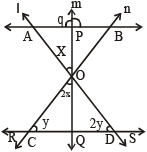दिया हुआ है कि AB और CD समांतर है यदि रेखा ℓ, m और n को बिन्दु O पर प्रतिच्छेद करती है, तो θ और ∠ODS का अनुपात ज्ञात करें.

Let the line m cut AB and CD at point P and Q respectively
∠ DOQ = x (exterior angle)
Hence, Y + 2x (corresponding angle)
∴ y = x ...(1)
Also . ∠ DOQ = x (vertically opposite angles)
In ∆ OCD, sum of the angles = 180⁰
∴ y + 2y + 2x + x =180°
⇒ 3x + 3y = 180°
⇒ x + y = 60 ...(2)
From (1) and (2)
x = y = 30 = 2y = 60
∴ ∠ ODS = 180 – 60 = 120°
∴ θ = 180 – 3x = 180 – 3(30) = 180 – 90 = 90°.
∴ The required ratio = 90 : 120 = 3 : 4.
